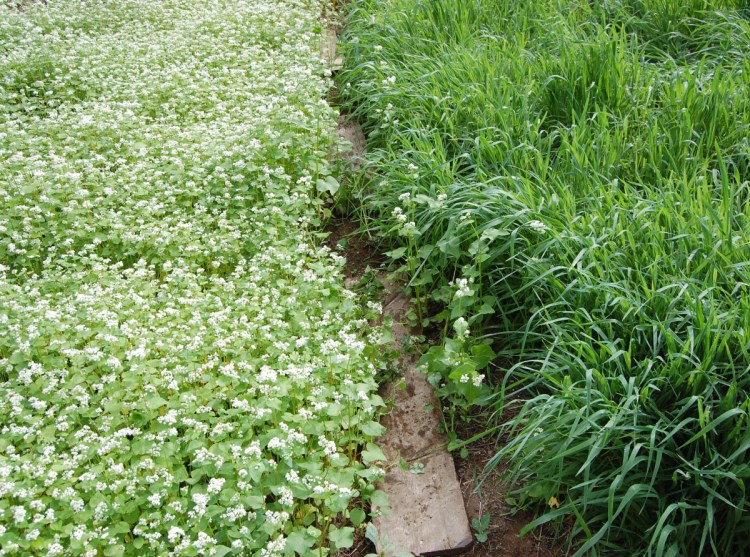It’s late September and my garden is literally humming. Whenever I go to harvest vegetables, I hear the pulsing drone of bees, flies and wasps amid buckwheat blossoms. To me, the flowers don’t look like much – tiny and soap white, but I clearly lack the cultivated taste of these pollinators. They buzz about giddy in a nectar nirvana.
When the blossoms are spent, I’ll turn in these plants. I don’t want the buckwheat to reseed as this garden patch is destined for garlic – which I’ll plant after the buckwheat has decomposed for a couple weeks.
I don’t grow buckwheat for the grain, but as a cover crop – a temporary placeholder that provides a wide array of benefits (beyond luring pollinators and looking beautiful en masse – like a dense pocket of spring wildflowers). Being a fast grower, buckwheat outcompetes weeds (even quackgrass!), helping hold space for later plantings. This crop went in where peas had grown and has kept the area weed-free for six weeks.
Cover crops suited to cooler soil temperatures, like oats and field peas, can also act as placeholders in early spring, suppressing weeds until the planting of warm-weather vegetables in late May or June.
Some cover crops – like clovers – add significant nitrogen to the soil, serving as a “green manure.” Buckwheat and oats, my favorites, don’t enrich the soil as much but improve its structure and “can capture and ‘recycle’ soluble nutrients otherwise lost,” Vern Grubinger of University of Vermont Extension writes. (Both grains also do well in acidic soils, which makes them right at home in my garden!)
Cover crops like oilseed or tillage radish can be used to break up compacted soil, with long taproots that loosen hardpan and draw up nutrients for future crops.
By serving as a living blanket, cover crops help minimize soil erosion. That protective function is increasingly important as we experience the brave new world of droughts and deluges. Whenever soil is exposed and dry, winds can carry it off. Sudden, intense downpours sweep away additional particles. My goal now is to shelter garden soil from the elements as much as possible – during the growing season and most especially through winter.
My preferred late-fall crop is common oats, which grow fast enough to start as other vegetables wind down (even into mid-October with our growing season lengthening). The earlier oats are planted, the more biomass they’ll provide, but even a few weeks growth can yield plants of 4-6 inches, enough to buffer soil from winter winds and spring rains.
Oats are a great choice for backyard gardeners as they winterkill. (Winter rye is favored by farmers, but it’s risky for those without tilling equipment as it resumes growth in the spring.) When oats die back, they form a protective mat on the soil that can easily be planted through in spring.
Vegetable gardens are inherently disturbed environments, but cover crops can provide a semblance of the natural cycles that characterize undisturbed meadows and forests – where biomass accumulates and decomposes, slowly building soils. They give soil bacteria an infusion of raw, local foods, rather than just compost and expensive soil supplements (often mined in distant places).
Most cover crops are economical, with organic seed sufficient for 100 square feet typically costing under five dollars. It’s cheaper to buy in bulk so consider going in with friends on larger bags (available from Maine suppliers like Fedco and Johnny’s).
To seed cover crops, prepare the bed, broadcast seeds, rake them in and water. Buckwheat and oats grow well with no subsequent watering even in relatively dry periods. If the planting season escapes you this fall, at least cover garden soils with some other mulch for the winter – like chopped leaves, dried grass clippings or straw.
Next year, I want to start using cover crops under established plants, a process known as undersowing or interseeding. This approach does not work with all vegetables (particularly roots and tubers) but apparently helps heavy feeders like winter squash and asparagus.
My commitment to cover cropping grew after reading an article by Claudia West, co-author of “Planting in a Post-Wild World,” in this year’s “Wild Seed” magazine (disclosure: I serve as its managing editor). West laments the environmental effects of “chronically under-vegetated” landscapes – like parking lot islands, ornamental plants set in seas of bark mulch and – I realized – many vegetable gardens. “Plants are the best mulch on Earth,” West notes, advocating for dense plant cover to provide habitat, minimize runoff, filter air, rebuild soil and absorb and store atmospheric carbon.
Realizing all those benefits in my own garden is gratifying. And seeing buckwheat blooms abuzz with pollinators – in the saffron light of a fall afternoon – makes me as happy as a nectar-fed bee.
ABOUT THE WRITER
MARINA SCHAUFFLER is a freelance journalist and editor (and a volunteer Master Gardener) whose work is online at www.naturalchoices.com.
Send questions/comments to the editors.



Success. Please wait for the page to reload. If the page does not reload within 5 seconds, please refresh the page.
Enter your email and password to access comments.
Hi, to comment on stories you must . This profile is in addition to your subscription and website login.
Already have a commenting profile? .
Invalid username/password.
Please check your email to confirm and complete your registration.
Only subscribers are eligible to post comments. Please subscribe or login first for digital access. Here’s why.
Use the form below to reset your password. When you've submitted your account email, we will send an email with a reset code.